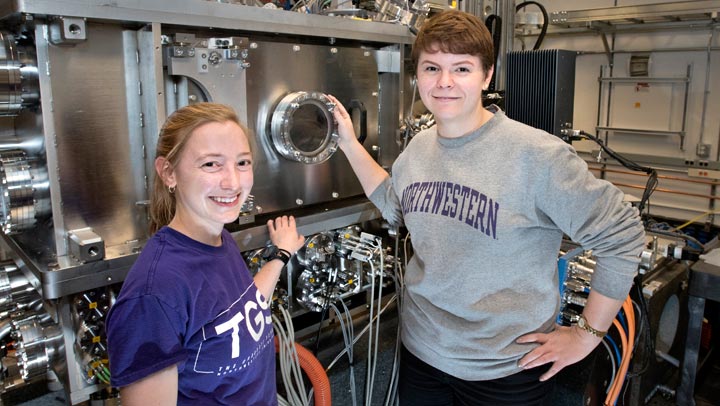NSLS-II User Profiles: Emmie Campbell & Karen DeRocher
November 23, 2015
 enlarge
enlarge
Emmie Campbell and Karen DeRocher, from the Biomineral Engineering group at Northwestern University's McCormick School of Engineering, studied microstructures that make up spicules or "bones" in larval sea urchins with the Hard X-Ray Nanoprobe at NSLS-II.
Emmie Campbell and Karen DeRocher are Ph.D. students in the McCormick School of Engineering at Northwestern University. They are members of the Biomineral Engineering group led by Derk Joester, an associate professor of materials science and engineering. They recently completed beam time at the Hard X-Ray Nanoprobe at Brookhaven National Laboratory’s National Synchrotron Light Source II (NSLS-II), a U.S. Department of Energy Office of Science User Facility.
"We’re interested in understanding how organisms control mineral growth. Bacteria, bumble bees, and even humans are able to produce biogenic magnetite at ambient pressure and temperature. If we can harness this kind of fabrication, we’d reduce energy, material, and labor costs for biogenic minerals, which tend to have novel and interesting properties."
— Emmie Campbell
What are your research interests?
We’re both interested in how organisms are able to manipulate crystal growth to deposit minerals with unique properties under biological conditions and with minimal energetic and material waste. But we took different paths to get to this field of materials science, and we plan to use what we learn in different ways.
Emmie Campbell:
I actually chose a field of materials science due to my interest in art history — my undergraduate degree is a double major in chemistry and art history. I worked at the Art Institute of Chicago through a Research Experiences for Undergraduates (REU) program with Northwestern, which inspired me to apply to the school's Materials Science department. For the big picture aspect of biomineralization, we’re interested in understanding how organisms control mineral growth. This includes things with obvious value, like better understanding human teeth and bone growth to reduce disease and discomfort, or technological value, like materially and energetically efficient fabrication. Materials like magnetite — a hard, magnetic material — are usually formed under high pressure and heat under geological conditions. However, bacteria, bumble bees, and even humans are able to produce biogenic magnetite at ambient pressure and temperature. This happens in your brain! If we can harness this kind of fabrication, we’d reduce energy, material, and labor costs for biogenic minerals, which tend to have novel and interesting properties, and possibly even extend what we’ve learned to other materials.
Karen DeRocher:
Since I was an undergraduate I have been interested in using materials science to develop new, more efficient materials for structural or energy applications. After hearing about Professor Joester’s work studying biominerals, I was intrigued by this different approach to materials science. Instead of taking the more commonly used approach of mixing materials together to come up with something new, we look at how organisms naturally produce minerals, such as calcite or apatite. While these materials can also be made in the lab (sometimes requiring elevated temperature and pressure), organisms are able to achieve very complex, intricate structures at ambient temperature and pressure. The thought of mimicking their production methods to make highly ordered, functional materials without having to expend a lot of energy excited me. After joining the Joester group, my main research interest has become studying the chemical and structural changes that occur in human enamel as a cavity develops. Eventually, we hope that this work will lead to a deeper understanding of enamel formation, as well as the development of better detection and treatment options for cavities.
What are you studying at NSLS-II?
We are studying the skeletons of larval sea urchins, which consist of two single-crystal calcite “bones,” called spicules. The spicules have a highly specialized morphology: instead of the highly faceted structure of inorganically precipitated calcite, the spicules have a cylindrical cross-section and smooth curves. There is a biomolecular basis for this growth, but we’ve observed a microstructure in the spicule that we believe is evidence of a faceted growth-front within the spicule, indicating a second growth mechanism. This is one of the things we studied using the Hard X-Ray Nanoprobe.
Why have you chosen NSLS-II for your research?
The spicule microstructure is 400-600 nanometers (nm) in diameter, comprised of 20 nm occlusions. The Hard X-Ray Nanoprobe is uniquely capable of resolving these features, utilizing x-ray fluorescence and x-ray differential phase contrast imaging.
This research is happening at the National Synchrotron Light Source II, which produces X-rays 10,000 times brighter than its predecessor (NSLS) and is the world’s brightest synchrotron light source.
Brookhaven National Laboratory is supported by the Office of Science of the U.S. Department of Energy. The Office of Science is the single largest supporter of basic research in the physical sciences in the United States, and is working to address some of the most pressing challenges of our time. For more information, please visit science.energy.gov.
2015-6056 | INT/EXT | Newsroom









